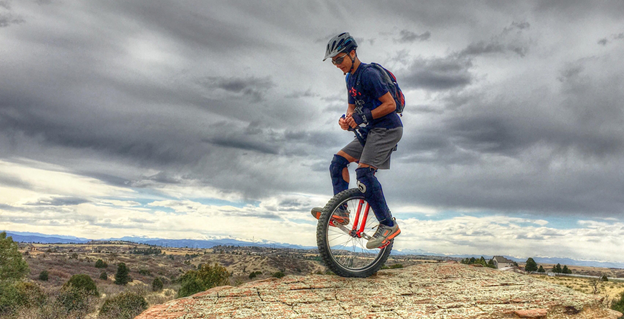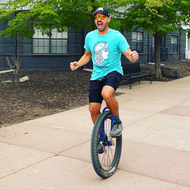Here’s What Happens If You Ride with Loose Square Taper Cranks
11/25/25
For those of you that aren’t yet familiar with the anatomy of crank arms, there are two main types of crank-hub-axle interfaces that are common in unicycles: these are splined cranks, of which ISIS cranks are a subset, and cotterless cranks, which are also (and more commonly) known as square taper cranks.
ISIS cranks are roughly star-patterned in cross-section and are more common on higher-end, more expensive unicycles such as commuting and mountain unicycles, whereas square taper cranks are common on beginner unicycles and pretty much all affordable unicycles.
They’re so named because if you take one off and look at the part that goes into the hub interface, it’s square in cross-section.
It’s also the case that if you ever ride with them loose, you will ruin them, and possibly deform the interface. The damage is irreversible in either case and will require you to get new crank arms or possibly a whole new unicycle, depending on the extent of the damage.
Let’s take a closer look at why this is.
If You Ride with Them Loose…
When you press a square taper crank into its fitting, before you tighten it, the friction fit between the two components is a product mostly of the corners of the cross-sectional square.
Therefore, when you go to crank the crank arm, the flat sides of the square provide the leverage necessary to turn the wheel.
This necessarily incurs an enormous amount of pressure on the corners of the square, which are natural stress risers where pressure is concentrated and amplified.
With the crank arm properly fitted and tightened, this is not that big of a deal, and the structure possesses the integrity to withstand its load without being damaged.
If, however, you attempt to ride a unicycle that has square taper cranks, but the crank arms are loose, then the corners of the crank arm’s taper won’t fit snugly into the interface.
As a result, the corners of the “square” will not align properly with the interface, which will potentially shear them off or round them off. Either way, either the interface, or the square taper portion of the crank arm, will be deformed.
Once the taper is deformed, it will either become loose or rotate entirely within the bracket. If it’s deformed sufficiently, the crank arm will turn without turning the wheel.
The prevention measure is easy enough. Just make sure that you don’t ever ride your unicycle with the crank arms loose, regardless of whether it has square taper cranks or not. There’s no good that can come of that.
Why Are Square Taper Cranks So Popular?
This begs the question: why are square taper cranks so popular? Well, mostly it comes down to simplicity and price. Most cotterless cranks are found on beginner unicycles as well as on affordable unicycles.
It takes less manufacturing resources and time to produce cotterless cranks, and so they are commonly encountered on beginner and cheap unicycles. That’s basically all there is to it.
Now, it should also be said here that while they are inherently simplistic, many models with cotterless cranks will still require a crank puller for you to remove the cranks arms if you ever want to replace them.
Why Replace Unicycle Cranks?

The main reason you might want to replace your unicycle’s crank arms is so you can either put on longer or shorter crank arms.
Shorter crank arms will be more responsive, and they will enable you to reach higher speeds if you can crank them faster since they will produce a tighter radius, but they also will require more strength, all things considered to operate.
Longer crank arms will give you better leverage over the wheel’s rotational momentum. While you won’t be able to reach the same speeds as easily with longer crank arms, you will probably have much greater overall concern over the unicycle.
All of this being said, it is important to note that if you are going to replace your unicycle’s crank arms, if your unicycle takes cotterless cranks, then you’ll still have to replace them with compatible cotterless crank arms.
Now, having addressed the potential shortcomings of square taper cranks in this article, if you are interested in an upgrade, you might want your next ride to have splined cranks.
A Sturdier Alternative for Your Next Unicycle
As stated at the outset of this article, a common alternative to cotterless cranks are splined cranks, such as ISIS cranks.
The nature of these cranks arms results in much greater overall surface area contact between the crank’s taper and the hub axle interface.
This makes the ISIS crank, along with other splined cranks, a much sturdier, stronger option for unicycle cranks, especially for models that will be raced, used for touring or commuting, ridden on trails, or used for trick riding or unicycle sports.
Models with splined cranks stand up much better to vigorous use and the pressure and power applied to the crank arms that would be exerted when trail riding, racing, clearing obstacles, and in similar situations.
However, while splined cranks are stronger, one thing you will need to observe with them is that they are always installed on the right side. There is a right and a left crank arm and they cannot be used interchangeably. Doing so would damage them, just as riding a cotterless model with the crank arms loose would damage it.
Explore Crank Arms, Pedals and Unicycle Tools Here
Whether you’re here for a new unicycle with splined cranks, or are looking for replacement crank arms for your existing unicycle, we carry the unicycle parts and tools you need to tackle the project.
Take a look through our collection and if you need more information, see our previous post, The Ultimate Guide to Unicycle Cranks, or get in touch with us directly and we’d be happy to help.

